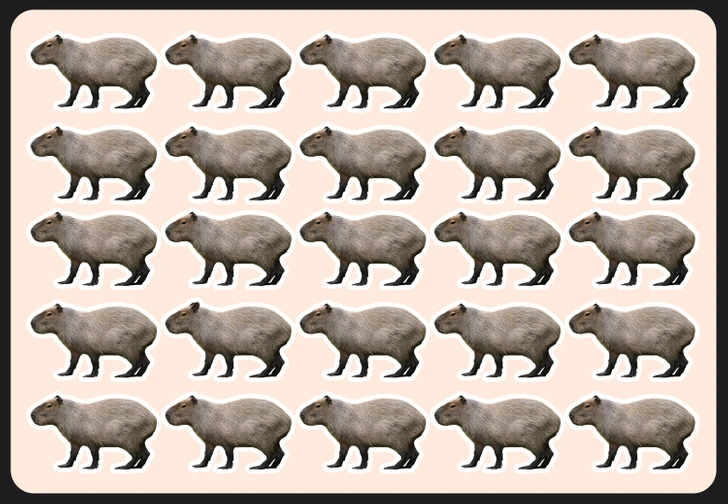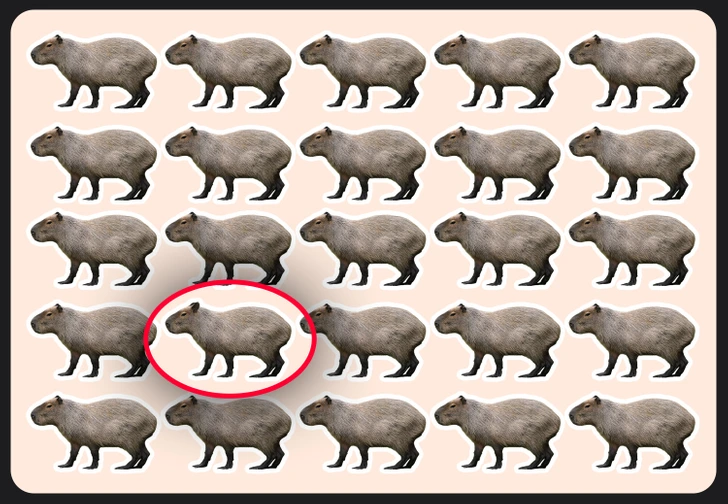Are you ready to challenge your brain and put your observation skills to the test? Here’s a fun and engaging “spot the difference” puzzle featuring the adorable capybara. It may look simple at first, but there’s one capybara that’s different from the rest. Can you find it?
Common Mistakes When Solving “Spot the Difference” Puzzles

If you’ve tackled “spot the difference” puzzles before, you know they can be deceptively tricky. While at first glance everything may seem identical, the differences can be subtle and hard to spot. One of the most common mistakes people make when solving these puzzles is rushing through the image. Thinking the differences will jump out at you might lead to missing those tiny but important details.
Why Small Details Matter
In puzzles like this one, it’s not always about the big features like the eyes or the body of the capybaras. Often, the key differences are in smaller features that aren’t immediately obvious. Maybe it’s a slight change in the position of an ear or a variation in the size of a tail. These minute differences are easy to overlook if you don’t take the time to study the image carefully.
Another common mistake is focusing too much on the background. The details surrounding the capybaras—like trees, rocks, or other animals—are distractions. Remember, the puzzle is all about the capybaras themselves, so keep your focus on them!
How to Tackle the Capybara Puzzle Step-by-Step
Ready to spot the different capybara? Let’s break it down into a simple, step-by-step guide to help you find the odd one out:
Step 1: Observe Each Capybara Closely
Take a deep breath and start by looking at each capybara in the image. Examine their faces, bodies, ears, tails, and paws. Capybaras are naturally similar in appearance, so the key to solving the puzzle is noticing the smallest differences.
Step 2: Check for Asymmetry or Abnormalities
Look carefully for any asymmetry or unusual features in the capybaras. Do any of them have an ear that seems bigger or positioned differently? Are their tails all the same length? In many cases, the difference you’re looking for could be something small, like a capybara with a slightly tilted head or an ear sticking out a bit more than the others.
Step 3: Pay Attention to the Face
The face is where a lot of the differences can hide. Capybaras are known for their round, friendly faces, but sometimes their eyes or ears might be slightly different in size or shape. Compare the positions of their eyes or the size of their ears—this is often the key to identifying the different capybara.
Step 4: Don’t Rush—Take Your Time
Patience is key in puzzles like this one. Take your time to examine each detail carefully. Often, the differences are subtle and easy to miss if you’re speeding through the puzzle. So, slow down and focus on the small details. The odd capybara is hiding in plain sight—it’s just a matter of taking your time to find it!
The Solution: What’s the Difference?
So, did you manage to spot the different capybara? If you haven’t found it yet, don’t worry—we’ve got the answer for you.

The key difference lies in the ears! One of the capybaras has longer ears than the others. While the rest have relatively short, rounded ears, this one capybara has ears that stick out noticeably longer. It’s a subtle detail, but once you know to look for it, it’s easy to spot.
Challenge Your Friends and Share the Puzzle
Now that you’ve solved the puzzle, it’s time to share your accomplishment with friends and family! Did you find the capybara with the longer ears? Or did you need a little help? Either way, you can challenge others to solve the puzzle and see if they can spot the difference faster than you.
By sharing this fun puzzle, you not only get to test your own observation skills, but you also encourage your friends to engage their minds. Puzzles like these are a great way to boost cognitive function while having a good time!
Why “Spot the Difference” Puzzles Are More Than Just Fun
At first glance, puzzles like this may seem like simple entertainment, but they offer so much more. “Spot the difference” challenges actually help improve important skills like attention to detail, problem-solving, and memory. These are all skills that can be applied to real-life situations, whether you’re trying to fix a problem at work or remember small but important details in your everyday life.
So next time you solve a puzzle like this, remember that it’s more than just a game—it’s a great way to enhance your cognitive abilities and keep your brain sharp.
Keep Your Mind Active with More Puzzles
Now that you’ve solved the capybara puzzle, why not keep the brain exercises going? There are countless other puzzles out there waiting to be solved. Whether it’s another “spot the difference” challenge, a word search, or a logic puzzle, each one provides an opportunity to sharpen your observation and problem-solving skills.
Don’t stop here—challenge yourself with more puzzles and keep your mind engaged. The more you practice, the better you’ll become at noticing even the smallest details, which can make a big difference in various aspects of your life.
Conclusion: A Fun Way to Boost Your Brainpower
Whether you found the different capybara easily or had to take a little longer to spot the longer ears, congratulations on completing the puzzle! It’s a fun and rewarding way to engage your brain and improve your observational skills.
And remember, puzzles like this aren’t just about having fun—they also train your brain to notice the little things. So keep solving, keep challenging yourself, and most importantly, share the fun with others. You never know what new details you’ll uncover next!


